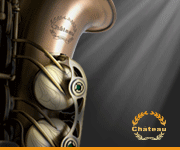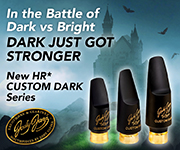 Forgot Username? Forgot Password?
Forgot Username? Forgot Password?
 SELMER U.S. Padless (1941-1942)
SELMER U.S. Padless (1941-1942)
The Selmer-U.S. Padless Saxophone operates under the same principles as a regular saxophone except that the “pad” is replaced by a flat metal plate and the edge of the tone hole is replaced by a tone ring. To make this work, each tone hole is surrounded by a socket. Soft, resilient "Tonex Tone Rings" are mounted in these sockets. Click on the photo to the left to clearly see the tone rings mounted in each tone hole. These tone rings are composed of three layers of differing synthetic materials that are blended togther to give the saxophone a solid feel when set up properly. The center layer is an air tight, water-resistant layer. Selmer claims to have tested over 300 different materials before settling on the final tone ring composition. A solid metal "Tone Booster" key plate closes on the tone ring in quite the opposite manner of how a traditional saxophone operates. Thus, a seal is made which is effectively the same as a traditional saxophone except here the entire pad cup is essentially one giant resonator. In this sense, the instrument was billed as having “twice” the volume, as being 120% more air tight, as having greater resonance and more brilliant tones, and as having a more defined articulation between the notes.
The Selmer-U.S. Padless Saxophone was the brainchild of musical instrument technician and inventor, Eugene Sander. As foreman of the saxophone department of H. & A. Selmer, Mr. Sander began researching the idea of a padless saxophone in 1938. After two years of R & D, a US patent was issued on December 30, 1940. By January of 1941 twelve working models had been manufactured with full production slated to begin in February. Production of this new model was cut short by WWII and the war effort as a Military Ordinance required that all instrument manufacturing be ceased in leu of war time production. Sadly, it was never revived after the war and the padless saxophone drifted off into the sunset of history.
Having been born in Germany in 1890, Mr. Sanders came to American at the age of two with his family and began a career in the musical instrument production trade in 1907. Despite coming from a musical family, Mr. Sanders was the only sibling of six not to learn to play an instrument.
This project was a collaboration between H. & A. Selmer and the Buescher Musical Instrument Company. It was a similar to the arrangement that H. & A. Selmer had with Selmer Paris, except in this instance, H. & A. Selmer was responsible for the design. Accordingly, the research, design, and patent expenses, as well as full assembly and quality control were all Selmer. However, the actual manufacturing of parts (body tube, bow, bell, neck, rods, key work, etc…) was all done by Buescher. Selmer designed and installed the “Tonex” tone booster rings. Selmer was also responsible for all marketing and distribution.
The instrument was hailed as the first major innovation in saxophone design in 100 years, since its invention by Adolphe Sax.
[less]The Selmer-U.S. Padless Saxophone operates under the same principles as a regular saxophone except that the “pad” is replaced by a flat metal plate and the edge of the tone hole is replaced by a tone ring. To make this work, each tone hole is surrounded by a socket. Soft, resilient "T... [more]
Serial Numbers:
| Beginning Year | Beginning Number |
|---|---|
| 1941 | 27000 |








